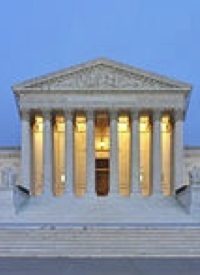
The Supreme Court of the United States has but modest status in the U.S. Constitution. The court is mentioned only in Article III, Section 1 and Section 2 of our founding document, and then just in passing. The office of Chief Justice exists mainly because after the impeachment of a President, it is that officer who presides over the Senate trial. In the Constitution, the very expression of this highest judicial body is not “Supreme Court,” but “supreme Court.”
What is the jurisdiction of the Supreme Court? It has original jurisdiction in cases involving either diplomats or states. Aside from that, although the Supreme Court has appellate jurisdiction, this jurisdiction can be limited in any way that Congress chooses. For instance, Congress could, if it wished, create a National Court of Appeal, which would have jurisdiction to handle nearly all the work which now flows through the Supreme Court. Congress could also create a federal court which handled nothing but questions about how to interpret the Constitution — and it could even invest this court with the power to issue “advisory opinions” and “declaratory judgments,” so that constitutional issues would not have to meander through the federal system for decades before being resolved. Congress could also remove from the Supreme Court, and all lower federal courts, jurisdiction over all issues related to the constitutionality of state abortion laws, for instance.
Congress could simply abolish all lower federal courts, if it felt that was appropriate — and as a matter of fact, it has done so before. The number of judges or justices on any federal court is determined by Congress as well, and that number may be decreased or increased. So Congress could not only “pack” the Supreme Court, but it could shrink it as well.
The power of the Supreme Court, the Circuit Courts of Appeal, and the Federal District Courts (those so-called “Article III” federal courts) has historically been even more constrained. District Courts — the trial courts in the federal judicial system — long heard only “diversity of citizenship” cases — involving parties who were citizens of different states, or nations. During the first century or so of the American Republic, “federal questions” — issues involving the enforcement of federal law or the U.S. Constitution — were heard for trial exclusively in state courts. The idea that federal law would be nearly always enforced by federal officers in federal courts would have flabbergasted American jurists in the 19th century.
In the last 50 years, however, Americans have witnessed a dramatic expansion of federal jurisdictional power. Federal judges now order cities to remove crosses from war memorials, direct the busing of millions of American grade-schoolers to distant institutions to achieve a prescribed racial mixture, and even discover “penumbra” rights to prenatal infanticide within the Constitution. These now-commonplace arrogations of power by federal judges help many to forget that there were once important jobs that the Supreme Court was supposed to perform.
The case of Montana v. Wyoming, initiated in January 2007 by the State of Montana in the U.S. Supreme Court, and argued this month before that body, is an excellent example. The two states involved in this litigation have been unable to agree about how to divide the water rights from the tributaries of the Yellowstone River. In this lawsuit, the Supreme Court is not hearing an appeal from lower federal courts or from a state supreme court; rather, the Supreme Court itself is the trial court. This is the sort of work that former Chief Justice William Rehnquist believed that the Supreme Court should not do, when he declared that the court “cannot sit to receive evidence or conduct trials.” Technically, the Supreme Court in this case is not acting as a trial court; it has appointed a special master to collect the evidence and make recommendations on how the court should rule.
The special master, Stanford law professor Barton Thompson, Jr., agrees with the argument made by Wyoming that an interstate agreement — the 1950 Yellowstone River Compact, a constitutional agreement which includes Wyoming, Montana, and North Dakota — provides limits on the amount of water that each state can divert, rather than consume. Thompson agrees with the argument made by Wyoming that the compact addresses the diversion of water and not the consumption of water. The compact was ratified by the legislatures of all three states and then approved by Congress. The compact itself produces regular reports on its activities, which provide background on the intention of the compact. Before the 1950 Yellowstone River Compact, three different interstate agreements had been negotiated between these states — in 1935, 1942, and 1944. The records and negotiation of these earlier accords help provide some context to interpretation of the current compact.
Anadarko Petroleum Corporation and the Northern Cheyenne Indian Tribe have filed amicus briefs in the lawsuit, and a dizzying flurry of pretrial motions have also been filed in the case.
The outcome of this lawsuit is not particularly important to our constitutional government. What is important and encouraging is that one of the original purposes of the Constitution — that such disputes between different states were to be resolved through litigation in which an impartial court hears the case — is actually playing out in this lawsuit between the two states, as the Supreme Court fulfills an important role which was clearly envisioned by our Founding Fathers.



